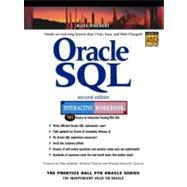
ALICE RISCHERT chairs the Database Application Development and Design track at the Computer Technology and Application Program at Columbia University. She has taught Oracle SQL to hundreds of students and has presented at Oracle conferences. Rischert has worked with Oracle for over 10 years and currently consults on large Oracle data warehouse and system integration projects.
Foreword by Peter Koletze
(NOTE: All chapters conclude with Test Your Thinking.)
Foreword.
Acknowledgments.
About the Author.
Introduction.
1. SQL and Data.
The New copy of this book will include any supplemental materials advertised. Please check the title of the book to determine if it should include any access cards, study guides, lab manuals, CDs, etc.
The Used, Rental and eBook copies of this book are not guaranteed to include any supplemental materials. Typically, only the book itself is included. This is true even if the title states it includes any access cards, study guides, lab manuals, CDs, etc.